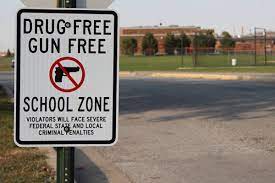
|
Getting your Trinity Audio player ready...
|
[Order David Horowitz’s new book, America Betrayed, HERE.]
In April, Iowa Gov. Kim Reynolds signed a bill into law that allows teachers to carry guns on school grounds. If an educator wants to participate in the program, he or she must go through a permit process that includes emergency medical and communication training, as well as quarterly firearm and annual “live scenario” training. The legislation applies to private and public K-12 schools and colleges.
Also, in April, Tennessee Gov. Bill Lee signed a law allowing teacher carry. Armed teachers and staff will be required to undergo 40 hours of training and then be allowed to carry handguns in their classrooms. The legislation also requires criminal and mental health background checks and a psychological examination.
Additionally, a concealed carry bill for teachers is in the works in West Virginia. House Bill 4299 would allow teachers who have concealed carry permits to keep a concealed gun at school. The proposed law also requires them to get training from law enforcement.
According to the United States Concealed Carry Association, 32 states now allow teachers and staff to carry firearms on campus. As USCCA notes, the laws vary from state to state. In some of them, either the individual school, school board, or school district must approve teacher carry. In Arkansas, the law only applies to teachers in private schools.
Educators are split on the idea. In the fall of 2022, the RAND Corporation surveyed teachers across the country, seeking their feedback on school safety issues. The results showed that
20% of respondents think allowing teachers to carry firearms makes schools safer, and 26% reported that they felt it wouldn’t affect school safety, while 54% said that policies allowing teachers to arm themselves would make schools less safe.
Not surprisingly, the National Education Association thinks arming teachers is a terrible idea. After the laws were passed in Tennessee and Iowa, the NEA posted a lengthy piece on its website excoriating the notion. Instead, the union thinks the Bipartisan Safer Communities Act, enacted in 2023, will go a long way to change things. The BSCA expands background checks before the purchase of firearms and targets interstate gun trafficking. It also supports state “red flag” laws, which allow courts to temporarily prevent someone in crisis from accessing guns and provides nearly $1 billion for mental health supports in public schools.
Whatever. The country, as well as individual towns, cities, and states, can pass a zillion laws, but with about 400,000,000 firearms in the U.S., any cruel or crazy person hellbent on mayhem and murder will be able to get his hands on one of them. And that person is most likely to exhibit his wickedness in a place where there is little chance of him encountering someone who will impede his evildoing. While the notion of “gun-free zones” sounds good, it is simple-minded. In reality, mass public shootings occur in gun-free zones 98.8% of the time.
A perfect case in point was several years ago when a lone gunman killed 12 people and wounded 58 at the Cinemark Century 16 Theater in Aurora, Colorado.
Why did the killer pick the Cinemark theater? Because it was a gun-free zone.
As John Lott, economist, political commentator, and gun rights advocate, wrote at the time, “You might think that it was the one closest to the killer’s apartment. Or that it was the one with the largest audience. Yet, neither explanation is right. Instead, out of all the movie theaters within 20 minutes of his apartment showing the new Batman movie that night, it was the only one where guns were banned. In Colorado, individuals with permits can carry concealed handguns in most malls, stores, movie theaters, and restaurants. But private businesses can determine whether permit holders can carry guns on their private property.”
Another example of a “gun-free zone” nightmare occurred in 2017 when a deranged gunman invaded Rancho Tehama Elementary School in rural California. As Kenneth Yuers reports, “I was teaching in a rural school about 20 minutes from a law enforcement response. About one year before November 2017, when the incident took place, I had qualified to get my CCW, concealed carry weapons permit. I’m a veteran in the Air Force, in law enforcement, and I asked the principal, ‘Hey, will I be allowed to carry here?’”
The principal said she didn’t think the district superintendent would allow it, so that was that.
Then, on Nov. 14, about 10 minutes before the school day began, Yuers heard gunshots and decided to bring the children inside seconds before the gunman rammed the school’s gates.
“He had shot at some parents on the way to school, and that’s what we had heard and reacted to as he shot his way out of the truck,” Yuers said. “I got my kids inside, but unfortunately there are still three students running caught in between the main part of the campus and where I was in my classroom, which was isolated.”
Although he didn’t see the gunman, he sensed what was happening.
Yuers explains, “He had an AR-15, and he was aiming to shoot them. I was standing at the door, and it was a terrible decision I had to make because I was unarmed. Do I potentially get shot, becoming a doorstop?”
All Yuers could do was barricade the classroom’s door with a computer charging cart. He told his 18 fourth and fifth-grade students to get down on the ground, according to a Time article written in the days after the attack.
Yuers says that the gunman was still able to enter, but “by the grace of God or something, his gun jammed.” A short time later, the gunman was shot and killed by law enforcement.
It’s important to note that while horrific, school shootings are extremely rare.
Education Week reported that there were 27 school shootings in 2022. This story was picked up by news outlets around the country. But as Reason’s Robby Soave writes, “The problem here is that three very differently defined terms are being used somewhat incautiously and interchangeably: school shooting, mass shooting, and mass school shooting. Uvalde was a mass school shooting; the 26 previous tragedies at schools this year were not.” For example, a 16-year-old student was shot and injured outside of a school after a basketball game.
On a similar note, a study conducted by criminologists for Scientific American, where only incidents that resulted in at least four deaths are included, found that there have been 13 mass school shootings taking the lives of 146 people in the U.S. since 1966.
“There is not an epidemic of mass shootings,” asserts James Alan Fox, a Northeastern University criminologist who has been tracking these events for decades and helps keep the AP/USA Today/Northeastern Mass Killing database. He adds, “What’s increasing and is out of control is the epidemic of fear.”
Fox adds that the “annual odds that an American child will die in a mass shooting at school are nearly 10 million to 1, about the odds of being killed by lightning or of dying in an earthquake.”
Also, to put things into perspective, 1,184 children 14 and younger were killed in traffic accidents in the U.S. in 2021. And, as the CDC reports, fatal drowning is the second-leading cause of unintentional injury death behind motor vehicle crashes for children ages 5–14.
Nonetheless, qualified educators should be armed if they so choose. These volunteers should go through a rigorous background check and proper police-type training and then be allowed to anonymously carry a concealed weapon on campus. Only the principal should know who the armed educators are.
Thankfully, 32 states—and counting—have some sort of teacher carry law in place.
Larry Sand, a retired 28-year classroom teacher, is the president of the non-profit California Teachers Empowerment Network – a non-partisan, non-political group dedicated to providing teachers and the general public with reliable and balanced information about professional affiliations and positions on educational issues. The views presented here are strictly his own.


Schools that Prohibit firearms should be sued and the Boards of Education made to read and post the U.S. Constitution in their Classrooms
Still clinging to that false hope that the “public (government) schools” can be reformed?
Gun free zones are nothing more than an invitation to anyone bent on carrying out a mass shooting. What a ridiculous idea!
Government schools are nothing more than shooting galleries. Home schools, not so much.
If this trend continues, we might soon be seeing a modern update of “The Breakfast Club.”
Mr. Vernon: Bender, you’re mine for the next three Saturdays.
Bender: Eat my shorts. I’m outta here.
Mr. Vernon: Go ahead. Make my day.
Well over half of the teachers are anti-gun leftists that would rather sacrifice your child to the shooter than be able to stop the shooter. It propagates their anti-gun agenda.
why so-called conservatives fall for this carry-a-gun-in -school-while-you-teach crap is depressing.. The fact is that All other countries –developed and third world– don’t have the type of gun violence that Americans exhibit. Teachers should NOT be asked to do double duty as security guards.